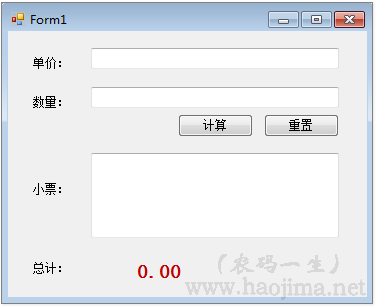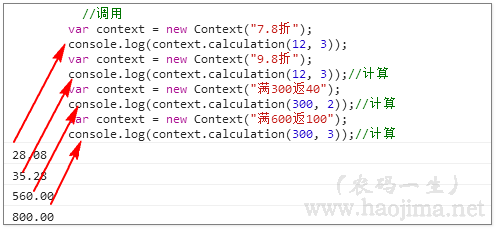面向对象编程思想(2)--策略模式
定义
策略模式
官方定义:定义了一系列的算法,并将每一个算法封装起来,而且使它们还可以相互替换。
个人理解:选择执行多个规则中的某个规则。
C#实现
需求1: 开发一个商场收银系统v1.0
三下五除二搞定

代码实现:
var price = Convert.ToDouble(txtPrice.Text);//单价
var number = Convert.ToDouble(txtNumber.Text);//数量
var lastTotal = Convert.ToDouble(labTotal.Text);//已购买金额
var money = price * number;//本次计算金额
labTotal.Text = (lastTotal + money).ToString();
txtContent.Text += string.Format("单价:{0},数量:{1},金额:{2}", price, number, money + "\r\n");
系统简单、方便、实用、性能好。...几个月过去,马上要国庆长假,老板为了促销决定全场8.8折。
需求2: 加入打折功能
因为项目工期紧,三下五除二又搞定
var price = Convert.ToDouble(txtPrice.Text);//单价
var number = Convert.ToDouble(txtNumber.Text);//数量
var lastTotal = Convert.ToDouble(labTotal.Text);//已购买金额
var discount = 0.88;//折扣(新增代码)
var money = price * number * discount;//本次计算金额
labTotal.Text = (lastTotal + money).ToString();
txtContent.Text += string.Format("单价:{0},数量:{1},折扣:{2},实际金额:{2}", price, number, discount, money + "\r\n");
很是自豪,我开发效率就是这么高。老板也甚是高兴。
...转眼假期就要过去了,打折的活动也要取消了。但是,由于这次的促销效果收益还不错。老板决定继续打折活动,折扣率要成为9.8折,且只是部分商品。不打折的商品则实行满300返40,满600返100。
不对劲啊,又的改代码。到了明年是不是又要8.8?老板的心思猜不透,但程序可以写得更灵活。所以我们要好好构思下。让系统可以选择优惠策略。
需求3: 修改打折,并加入返现功能

代码实现如下
var price = Convert.ToDouble(txtPrice.Text);//单价
var number = Convert.ToDouble(txtNumber.Text);//数量
var lastTotal = Convert.ToDouble(labTotal.Text);//已购买金额
var money = price * number;//本次计算金额
switch (cmBstrategy.Text)//下拉框
{
case "8.8折":
money *= 0.88;
break;
case "9.8折":
money *= 0.98;
break;
case "满300返40":
if (money >= 300)
{
money -= 40;
}
break;
case "满600返100":
if (money >= 600)
{
money -= 100;
}
break;
}
labTotal.Text = (lastTotal + money).ToString();
txtContent.Text += string.Format("单价:{0},数量:{1},促销:{2},实际金额:{3}", price, number, cmBstrategy.Text, money + "\r\n");
现在我们的收银员可以灵活切换优惠活动,且保留的原有的优惠策略。不过我们从代码层面考虑的话,还有多处不足。
- switch条件分支语句难以阅读和维护。
- 如果我们需要修改新增优惠策略的话,需在界面代码里面修改。
根据面向对象的思想,应该封装变化。于是,我们的策略模式可以登场了。
代码重构 使用策略模式实现以上需求
var price = Convert.ToDouble(txtPrice.Text);//单价
var number = Convert.ToDouble(txtNumber.Text);//数量
var lastTotal = Convert.ToDouble(labTotal.Text);//已购买金额
var context = new Context(cmBstrategy.Text);//新增代码
var money = context.Calculation(price, number);//新增代码
labTotal.Text = (lastTotal + money).ToString();
txtContent.Text += string.Format("单价:{0},数量:{1},促销:{2},实际金额:{3}", price, number, cmBstrategy.Text, money + "\r\n");
我们发现中间那段条件分支不见了,多了一个Context类。
public class Context
{
//策略抽象类
private AmountCalculation amountCalculation;
public Context(string type)
{
switch (type)
{
case "8.8折":
amountCalculation = new Rebate(0.88);
break;
case "9.8折":
amountCalculation = new Rebate(0.98);
break;
case "满300返40":
amountCalculation = new Cashback(300, 40);
break;
case "满600返100":
amountCalculation = new Cashback(600, 100);
break;
}
}
//计算金额
public double Calculation(double price, double number)
{
return amountCalculation.Calculation(price, number);
}
}
里面有类Rebate折扣计算、Cashback返现计算。
//折扣计算
public class Rebate : AmountCalculation
{
private double discountRate;
public Rebate(double discountRate)
{
this.discountRate = discountRate;
}
public override double Calculation(double price, double number)
{
return price * number * discountRate;
}
}
// 返现
public class Cashback : AmountCalculation
{
//满多少
private double exceed;
//返多少
private double retreat;
public Cashback(double exceed, double retreat)
{
this.exceed = exceed;
this.retreat = retreat;
}
public override double Calculation(double price, double number)
{
var momoney = price * number;
if (momoney >= exceed)
{
return momoney - retreat;
}
return momoney;
}
}
看到这里,是不是明白了策略模式呢?
如果现在老板再需要我们价格折扣或是返现的活动,相比之前需要在长段的界面逻辑代码里面修改,现在要方便得多了。
第一、先在界面添加一个活动如加一个7.8折,然后界面代码就不用动了。
第二、在Context类里面加一个7.8折
switch (type)
{
//新增
case "7.8折":
amountCalculation = new Rebate(0.78);
break;
JS实现
上面用C#实现了策略模式,接下来我们尝试使用js来实现。还是借用用上面的商场活动业务。
js不同于传统的面向对象,无类、不需要实现抽象类。
//策略计算
var strategies = {
//返现 exceed:满多少 retreat:返多少 momoney:应付金额
cashBack: function (exceed, retreat, momoney) {
if (momoney >= exceed) {
return (momoney - retreat).toFixed(2);
}
return momoney;//返现后实付金额
},
//打折 discountRate:折扣率 momoney:应付金额
rebate: function (discountRate, momoney) {
return (discountRate * momoney).toFixed(2);//折扣后实付金额
}
}
//上下文
var context = {
"7.8折": function (price, number) {
var momoney = price * number;
return strategies.rebate(0.78, momoney);
},
"9.8折": function (price, number) {
var momoney = price * number;
return strategies.rebate(0.98, momoney);
},
"满300返40": function (price, number) {
var momoney = price * number;
return strategies.cashBack(300, 40, momoney);
},
"满600返100": function (price, number) {
var momoney = price * number;
return strategies.cashBack(600, 100, momoney);
}
}
//计算结果
var calculateBonus = function (level, price, number) {
return context[level](price, number);
};
//调用
console.log(calculateBonus('7.8折', 12, 3));//计算
console.log(calculateBonus('满600返100', 12, 3));//计算
console.log(calculateBonus('满300返40', 2, 23));//计算
console.log(calculateBonus('9.8折', 2, 33));//计算
结果如下:

相对于面向对象语言的实现要更加的清晰明了。
那么js可以模拟面向对象的实现吗?答案是肯定的。
首先定义返现实现类:
//返现 exceed:满多少 retreat:返多少
var CashBack = function (exceed, retreat) {
this.exceed = exceed;
this.retreat = retreat;
};
//计算方法
CashBack.prototype.calculate = function (price, number) {
var momoney = price * number;
if (momoney >= this.exceed) {
return (momoney - this.retreat).toFixed(2);
}
return momoney;//返现后实付金额
}
打折类
//打折 discountRate:折扣率 momoney:应付金额
var Rebate = function (discountRate) {
this.discountRate = discountRate;
};
//计算方法
Rebate.prototype.calculate = function (price, number) {
return (price * number * this.discountRate).toFixed(2);//折扣后实付金额
}
策略上下文
//上下文
var Context = function (type) {
this.type = type;
}
Context.prototype.calculation = function (price, number) {
var AmountCalculation;
switch (this.type) {
case "7.8折":
AmountCalculation = new Rebate(0.78);
break;
case "9.8折":
AmountCalculation = new Rebate(0.98);
break;
case "满300返40":
AmountCalculation = new CashBack(300, 40);
break;
case "满600返100":
AmountCalculation = new CashBack(600, 100);
break;
}
return AmountCalculation.calculate(price, number);
}
调用如下:
//调用
var context = new Context("7.8折");
console.log(context.calculation(12, 3));
var context = new Context("9.8折");
console.log(context.calculation(12, 3));//计算
var context = new Context("满300返40");
console.log(context.calculation(300, 2));//计算
var context = new Context("满600返100");
console.log(context.calculation(300, 3));//计算

虽然对于js语言特性直接实现策略模式来说,面向对象的代码量比较多。可是对于我们后端人员new一个对象的使用方式应该更习惯。
策略模式场景
- 排序算法的选择冒泡排序、选择排序、快速排序、插入排序
- 压缩算法的选择zip、rar、rar5...
- 旅游交通工具的选择飞机、火车、汽车...
总结
策略模式通过Context上下文对具体策略进行封装,供高层直接调用而不用关系策略的具体实现。然后Context本身通过不同情况实例不同的抽象实现类(具体策略类),来执行具体策略。从而实现了具体策略的自由切换,易于新策略的扩展。
本文已同步至索引目录:《设计模式学习》
本文demo:https://github.com/zhaopeiym/BlogDemoCode
- 学习本是一个不断抄袭、模仿、练习、创新的过程。
- 虽然,园中已有本人无法超越的同主题博文,为什么还是要写。
- 对于自己,博文只是总结。在总结的过程发现问题,解决问题。
- 对于他人,在此过程如果还能附带帮助他人,那就再好不过了。
- 由于博主能力有限,文中可能存在描述不正确,欢迎指正、补充!
- 感谢您的阅读。如果文章对您有用,那么请轻轻点个赞,以资鼓励。
- 工控物联Q群:995475200
 我们大多时候用着面向对象的语言,写着面向过程的代码。
学习设计模式不是死搬硬套,更不是为了模式而模式。
我们学习设计模式是要学习其中的编程思想,面向对象的的思想。
设计模式就像是拳法一样,拳法只是用来练习的。你实战的时候一定不会打完上一个动作再打下一个动作。我们要做到融会贯通、运用自如,达到手中无剑,心中有剑,人剑合一的境界。
我们大多时候用着面向对象的语言,写着面向过程的代码。
学习设计模式不是死搬硬套,更不是为了模式而模式。
我们学习设计模式是要学习其中的编程思想,面向对象的的思想。
设计模式就像是拳法一样,拳法只是用来练习的。你实战的时候一定不会打完上一个动作再打下一个动作。我们要做到融会贯通、运用自如,达到手中无剑,心中有剑,人剑合一的境界。

 浙公网安备 33010602011771号
浙公网安备 33010602011771号